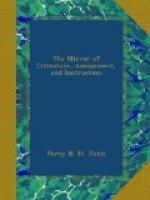In 1830, Mr. Nasmyth sold his valuable collection of original sketches and drawings for thirty pounds to George Pennell, Esq., who also purchased several of his exquisitely finished pictures, one of which—a View in Lee Wood, near, Bristol—is now in the possession of Lord Northwick. Nasmyth was a constant exhibitor at the Royal Academy, the British Institution, &c., and his performances delighted the uninstructed spectator as well as the connoisseur.
In person, he was of the middle stature, and possessed a manly countenance with an agreeable figure. In conversation he was vivacious and witty, especially when in company with a convivial party. His character, in some respects, was similar to that of George Morland; he was rather too much addicted to convivial pleasures, yet was ever solicitous to mix with the best company, and his polite manners always rendered him an acceptable guest; in this respect he was unlike Morland, who, it is well known, loved to select his companions from the lowest class of society. Although Nasmyth obtained considerable sums for his pictures, he was never sufficiently economical to save money; on the contrary his private affairs were in a very deranged state. He was never married, and during the last ten years of his life resided at Lambeth.
Towards the end of July, 1831, Mr. Nasmyth, accompanied by two of his intimate acquaintances, made an excursion to Norwood for the purpose of sketching. Much rain had fallen the day before, and the air was still chilly; the artist, however, commenced his drawing, and remained stationary for about two hours, when, the sketch being finished, he rejoined the friends whom he had left at an inn. He then complained of being excessively cold, but on taking something warm his usual spirits returned, and the party passed the rest of the day pleasantly. On the following morning, however, Nasmyth felt considerably indisposed, and it appeared evident he had taken a violent cold. Notwithstanding medical assistance, his indisposition daily increased; and on the 18th of August he breathed his last, in the 46th year of his age.
He died in extreme poverty, and a subscription to defray the expenses of the funeral was raised among his friends. Wilson, Stanfield, and Roberts subscribed, and followed the remains of their late talented friend to the grave in St. Mary’s churchyard, Lambeth.




